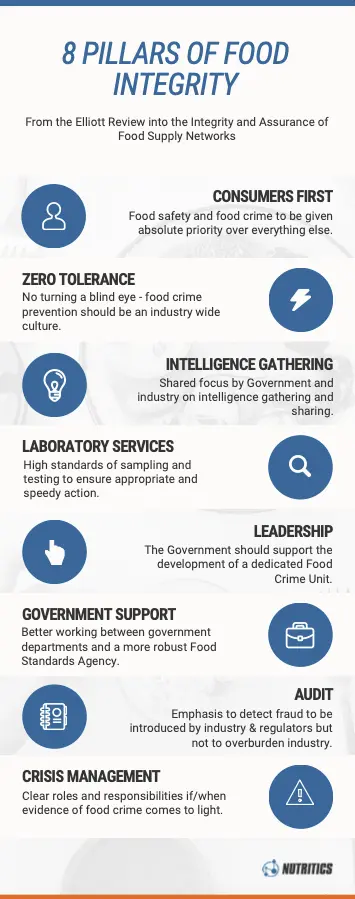Food crime is not a new concept. As long as food has been sold, there have been people participating in its adulteration, mislabelling and cheating.
The name ‘Champagne’ is legally protected and is reserved for sparkling wines produced in the Champagne region of France. According to research, however, the amount of Champagne sold annually is triple its official supply (1). This means that beverages are falsely being labelled as Champagne for economic gain.
Manuka honey is derived from the Manuka plant native to New Zealand and is known for its antibacterial and antimicrobial properties (2). In 2014, 10,000 tonnes of this ‘liquid gold’ were sold, while only 1,700 tonnes of genuine Manuka honey were produced in New Zealand, meaning that as much as 80% of the Manuka honey on the market was fake.
These are just some examples of fraud that can affect the everyday lives of consumers. Fraud can also manifest as the bulking of products (for example, expensive spices contaminated with nut shells) and products past their sell-by date being restamped and put back onto market. These crimes are all examples of the economically motivated adulteration of Food (EMA).
EMA is a type of fraud and is defined by the US Food and Drug Administration as “the fraudulent, intentional substitution or addition of a substance in a product for the purpose of increasing the apparent value of the product or reducing the cost of its production” (3).
The impact of food crime and fraud can be severe and far-reaching. Potential health risks such as allergens and carcinogens, nutritional deficiencies, economic loss and the feeling of being cheated can leave the consumer with a bad taste in their mouth. Business owners risk letting their customers down, damaging their reputation and incurring financial losses.
In 2008, a fraud incident known as the melamine milk scandal showed that fraud can not only have economic implications, but also an impact on public health. Infant formula in the Gansu Province of China was adulterated with melamine to increase the protein content of the milk. Overall, 294,000 infants in various regions in China experienced effects on the urinary tract system and kidneys, and six deaths were reported as a result of the adulteration of the infant formula (4).
In Europe, fraud was abruptly brought into the public eye by the horsemeat scandal of 2013. The Food Safety Authority of Ireland uncovered that some beef containing products contained undeclared or improperly declared horse meat (5).
In response to this incident and subsequent concerns over the systems in place to tackle the adulteration of food, the UK government commissioned a review of the country’s supply chain in June 2013. The following year, Professor Chris Elliott published his National Food Crime Prevention Framework which included the 8 Pillars of Food Integrity (6) .

Fraud is still a very real issue. A recent report on EU Customs revealed that in 2017, 24% of all goods detained at EU borders were foodstuffs suspected of infringing intellectual property rights which cover areas such as protected designation of origin and protected geographical indications . Foodstuffs are now the number 1 category of articles detailed, pushing toys and cigarettes to 2nd and 3rd place respectively for counterfeit goods detained. The original retail value for the foodstuffs detailed values €2,274,866 – demonstrating that food fraud is still big business (7).
Fighting food crime
The power of observation
The UK’s government have established the National Food Crime Unit (NFCU) that helps protect consumers from food safety issues that are a direct result of criminal activity. Further information about reporting suspicious behaviour and what the NFCU are involved with, can be found here.
Prevention is key
Businesses are vulnerable to fraud from both internal and external sources. It is important that vulnerability to crime is assessed and measures are put into place to minimise the threat from food crime (8).
In 2016, scientists developed an easy-to-read, paper-based test for certain strains of Salmonella and E. coli, that may be performed by workers without special training (9). Innovations such as this may help facilitate business owners to combat crime, without expensive testing.
Business owners can assess their vulnerability to food fraud with the help of a free tool created by the non-profit organisation SSAFE (Safe Supply of Affordable Food for Everyone Everywhere). The tool is available as an app which may be downloaded from the App Store or Google Play (10).
If you’re concerned about how to fulfil your obligations under EU law, check out our blog post on fulfilling EU food labelling requirements.
References
- Lowe E, Lowe N. An update on food crime since the Elliott Review [Internet]. 2015 [cited 2018 Oct 5]. Available from: https://www.birminghamfoodcouncil.org/wp-content/uploads/2015/01/Update_on_food-crime_since-the_Elliott_Review_May2015.pdf
- Ministry for Primary Industries. A New Zealand Government Department. Mānuka honey [Internet]. [cited 2018 Oct 1]. Available from: https://www.mpi.govt.nz/growing-and-harvesting/honey-and-bees/manuka-honey/
- Johnson R. Food Fraud and “Economically Motivated Adulteration of “Food and Food Ingredients”. 2014.
- Wang Z, Luo H, Tu W, Yang H, Wong WH-S, Wong W-T, et al. Melamine-tainted milk product-associated urinary stones in children. Pediatr Int. 2011 Aug;53(4):489–96.
- Food Safety Authority of Ireland. Horse DNA found in some beef burger products [Internet]. 2013 [cited 2018 Oct 5]. Available from: https://www.fsai.ie/details.aspx?id=11878
- Elliott C. Elliott Review into the Integrity and Assurance of Food Supply Networks-Final Report A National Food Crime Prevention Framework [Internet]. 2014 [cited 2018 Oct 5]. Available from: https://assets.publishing.service.gov.uk/government/uploads/system/uploads/attachment_data/file/350726/elliot-review-final-report-july2014.pdf
- European Union. Report on the EU customs enforcement of intellectual property rights: Results at the EU border 2017. 2018 [cited 2018 Oct 11]; Available from: https://ec.europa.eu/taxation_customs/sites/taxation/files/report_on_eu_customs_enforcement_of_ipr_2017_en.pdf
- van Ruth SM, Huisman W, Luning PA. Food fraud vulnerability and its key factors. Trends Food Sci Technol. 2017 Sep 1;67:70–5.
- Park J, Shin JH, Park J-K. Pressed Paper-Based Dipstick for Detection of Foodborne Pathogens with Multistep Reactions. Anal Chem. 2016 Apr 5;88(7):3781–8.
- Price Waterhouse Cooper. Food fraud vulnerability assessment [Internet]. 2014 [cited 2018 Oct 5]. Available from: www.ssafe-food.org